Journal Club: The decline and fall of showy bustards
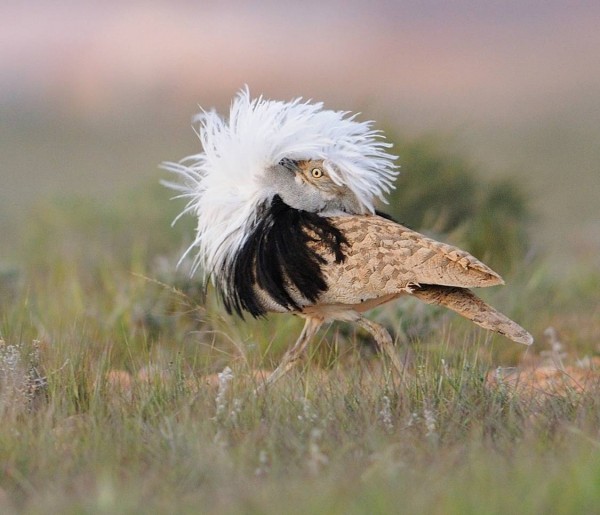
SUMMARY: intense early reproductive effort takes a toll on long-term survival of individual male houbara bustards by leading to early declines in fertility and early ageing
![]() Why do we get old and die? Why hasn’t natural selection “weeded out” those genes responsible for age-related declines? Several hypotheses have been proposed, with the most important pointing at the inherent “riskiness” of life. Since most living things don’t survive to old age, deleterious age-related genes or phenotypes may never be expressed and thus, are not available for natural selection to act upon.
Why do we get old and die? Why hasn’t natural selection “weeded out” those genes responsible for age-related declines? Several hypotheses have been proposed, with the most important pointing at the inherent “riskiness” of life. Since most living things don’t survive to old age, deleterious age-related genes or phenotypes may never be expressed and thus, are not available for natural selection to act upon.
Another hypothesis argues that genes or phenotypes that are beneficial early in life can be selected for even though they have negative effects later, effects like senescence. One such hypothesis — which we might think of as the “live fast and die young” hypothesis — blames reproduction for ageing. It proposes that increased reproductive investment actually occurs at the expense of physiological declines in later life (Williams, 1957; free PDF). As any exhausted parent will probably tell you, this hypothesis might actually have merit. Currently, there is little hard data available from long-lived species to adequately test any of these hypotheses.
But birds are long-lived animals (living much longer than similarly-sized mammals, for example). Because at least some bird species are being managed in captive-breeding programmes, there are huge amounts of data that could be used in such studies. One such long-lived captively-managed species is the houbara bustard, Chlamydotis undulata.
The houbara bustard is a sand-coloured goose-sized bird with long legs that dwells in the deserts of Egypt and throughout northern Africa. Like many bird species, male houbara bustards grow elaborate nuptial plumage and engage in courtship displays that are instrumental for advertising each male’s qualities to females (see video):
Displaying male houbara bustard, Chlamydotis undulata.
Credit: Yves Hingrat (with permission). DOI: 10.1111/j.1461-0248.2011.01668.x.
Male houbara bustards form exploded leks to compete with each other by emitting subsonic “booming” sounds, whilst showing off their extravagant plumage with flamboyant dances to passing females. After the males have established a hierarchy, the females preferentially mate with the dominant males.
Lekking presents huge reproductive payoffs for the fittest males, so competition can be fierce. For example, the typical male houbara bustard displays for 18 hours per day for as long as 6 months at a time, losing as much as 10 percent of his body weight. Yet despite the males’ obvious efforts to impress, female houbara bustards are promiscuous: 60 percent of their clutches have multiple fathers. Thus, in addition to being showy, males must also produce large and high-quality ejaculates so they can win the ensuing sperm competition, too.
Houbara bustards are endangered due to human persecution (for some reason, the local people believe bustard flesh is an aphrodisiac). Fortunately, houbara bustards are popular quarry for falconers, and since Middle Eastern falconers tend to be royalty, this species has been conserved for many generations by a number of captive-breeding programmes.
“The birds are a threatened species, and the data was collected as part of an ongoing conservation programme aimed at increasing their numbers in the wild,” said the study’s lead author, Brian Preston, an ecologist at the Université de Bourgogne in France.
The data analysed by Dr Preston’s team were collected by the Emirates Centre for Wildlife Propagation, which breeds houbara bustards in eastern Morocco. One particularly interesting aspect of this captive-breeding programme is that the birds are bred using artificial insemination — and the viability of the sperm in each ejaculate is carefully assessed after collection since abnormal sperm present obvious fitness costs for the birds (and for the conservation programme!). But because spermatogenesis is particularly vulnerable to senescence, these records were important for this study: the team analysed the records that documented 158,799 individual ejaculates produced by more than 1700 captive-bred male bustards ranging from 1 to 24 years of age.
The team first compared display time to age-related changes in sperm quality for each bird (figure 1):
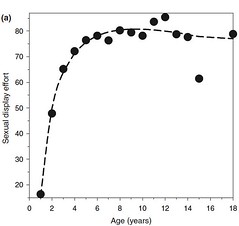
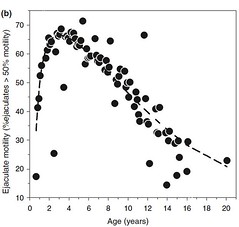
Figure 1 a & b.
DOI: 10.1111/j.1461-0248.2011.01668.x
They found that the rate at which males display reaches a plateau at 6 years of age, and changes little afterward (click for larger view: figure 1a). However, this was not the case for sperm motility, which peaks at four years of age, and shows a significant decline afterward (click for larger view: figure 1b).
The team found that sperm suffered in other ways too, showing declines in quality that are commonly associated with senescence (figure 2):



Figure 2 a, b & c.
DOI: 10.1111/j.1461-0248.2011.01668.x
The sexual displays of both “young” (up to 6 years of age; white circles) and “old” (more than 6 years of age; black circles) birds correlated to the numbers of sperm per ejaculate (click for larger view: figure 2a), sperm motility (click for larger view: figure 2b), and the percentage of morphologically normal sperm produced (click for larger view: figure 2c) — all of which affect fertility. As the team’s data clearly show, all males experienced a “dramatic decline” in their fertility as they aged.
“Over the age of six years, they began to produce much smaller ejaculates with immobile and frequently abnormal sperm”, remarked Dr Preston. But the team wanted to know whether those birds that invested most into their displays whilst young suffered the greatest declines in fertility as they aged.
To answer that question, they developed a mathematical model based on these data to estimate sexual display effort at the birds’ physiological prime (4 years of age) and they used that to predict the birds’ subsequent decline in fertility (figure 3):
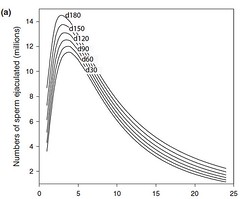

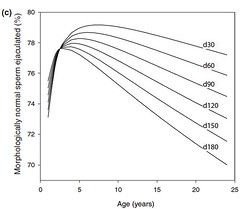
Figure 3 a, b & c.
DOI: 10.1111/j.1461-0248.2011.01668.x
This model suggested that as male bustards aged, those that showed the highest display rate “burned out” more quickly than their less intense brethren. Those males that displayed for longer periods of time (varying from 30 days [d30] to 180 days [d180] per year, respectively) showed increasingly more dramatic declines in the number of sperm per ejaculate (click for larger view: figure 3a), sperm motility (click for larger view: figure 3b) and percentage of morphologically normal sperm (click for larger view: figure 3c).
“The bustard shows that an over-abundance of early reproductive effort comes at the cost of physiological declines later in life”, explained Dr Preston in email.
These data support the “live fast and die young” hypothesis that animals might “overspend” on reproductive activities in their early life. This “overspending” may in fact cause the birds to “burn out” whilst still young.
“Life is risky,” said Dr Preston. “Predators, parasites and diseases are likely to prevent animals from living for long periods anyway. So it might be better for them to spend now and not worry about later.”
Interestingly, even though the birds in this study reached their sexual peak at 4 years of age, they continued their courtship displays at the same rate for another 20 years — a trait that might have wider implications than just for bustards.
“This is the bird equivalent of the posers who strut their stuff in bars and nightclubs every weekend,” remarked Dr Preston in a press release. “If the bustard is anything to go by, these same guys will be reaching for their toupees sooner than they’d like.”
This early- versus late-life trade-off can help explain why senescence occurs, and reveals the potential significance of sexual selection in explaining rates of aging.
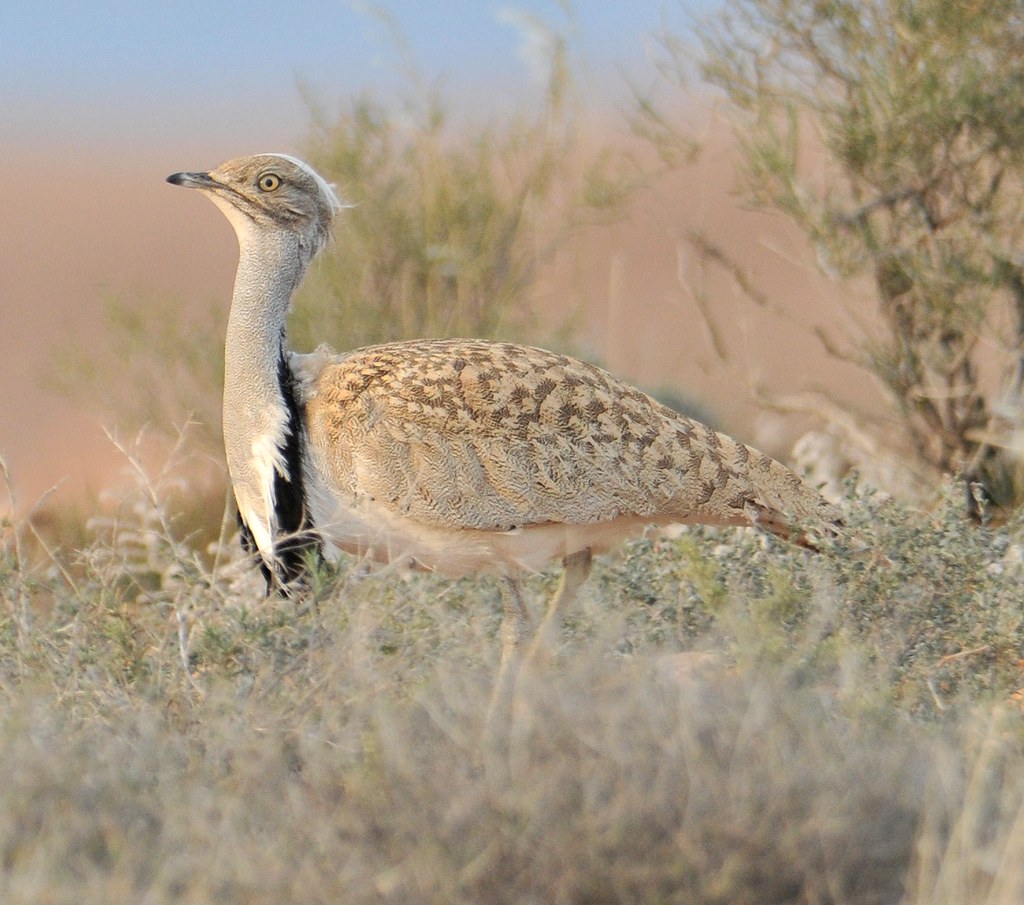
Male houbara bustard, Chlamydotis undulata.
Image: Yves Hingrat (with permission). DOI: 10.1111/j.1461-0248.2011.01668.x [velociraptorise].
Sources, background and supporting materials:
Preston, B., Jalme, M., Hingrat, Y., Lacroix, F., & Sorci, G. (2011). Sexually extravagant males age more rapidly. Ecology Letters DOI: 10.1111/j.1461-0248.2011.01668.x
Ben Norman, Wiley [emails; 4 August 2011]
Brian Preston, co-author [emails; 4 August 2011]
Images & video: Yves Hingrat, via Ecology Letters (with permission).
This research was funded by the Emirates Centre for Wildlife Propagation, which also collected and provided the data for this project under the leadership of the International Fund for Houbara Conservation.
GC Williams. (1957). Pleiotropy, natural selection, and the evolution of senescence. Evolution 11:398-411. [free PDF]
.. .. .. .. .. .. .. .. ..
twitter: @grrlscientist
facebook: grrlscientist
email: grrlscientist@gmail.com
